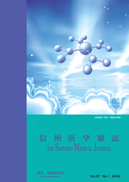Volume 59, Issue 1
Displaying 1-10 of 10 articles from this issue
- |<
- <
- 1
- >
- >|
Foreword
-
2011 Volume 59 Issue 1 Pages 1-2
Published: 2011
Released on J-STAGE: March 03, 2011
Download PDF (139K)
Review
-
2011 Volume 59 Issue 1 Pages 3-11
Published: 2011
Released on J-STAGE: March 03, 2011
Download PDF (561K)
Original
-
2011 Volume 59 Issue 1 Pages 13-26
Published: 2011
Released on J-STAGE: March 03, 2011
Download PDF (971K)
Case Report
-
2011 Volume 59 Issue 1 Pages 27-31
Published: 2011
Released on J-STAGE: March 03, 2011
Download PDF (343K)
Current Topics
-
2011 Volume 59 Issue 1 Pages 33-35
Published: 2011
Released on J-STAGE: March 03, 2011
Download PDF (247K)
Round the World
-
2011 Volume 59 Issue 1 Pages 36
Published: 2011
Released on J-STAGE: March 03, 2011
Download PDF (164K)
My Choice of Speciality
-
2011 Volume 59 Issue 1 Pages 37
Published: 2011
Released on J-STAGE: March 03, 2011
Download PDF (213K)
Book Review by Author
-
2011 Volume 59 Issue 1 Pages 38-39
Published: 2011
Released on J-STAGE: March 03, 2011
Download PDF (155K)
Abstract of Meetings
-
2011 Volume 59 Issue 1 Pages 41-46
Published: 2011
Released on J-STAGE: March 03, 2011
Download PDF (405K) -
2011 Volume 59 Issue 1 Pages 47-56
Published: 2011
Released on J-STAGE: March 03, 2011
Download PDF (544K)
- |<
- <
- 1
- >
- >|
